Solar eclipse of May 9, 1948
An annular solar eclipse occurred on May 9, 1948. A solar eclipse occurs when the Moon passes between Earth and the Sun, thereby totally or partly obscuring the image of the Sun for a viewer on Earth. An annular solar eclipse occurs when the Moon's apparent diameter is smaller than the Sun's, blocking most of the Sun's light and causing the Sun to look like an annulus (ring). An annular eclipse appears as a partial eclipse over a region of the Earth thousands of kilometres wide. Annularity was visible from Car Nicobar, the northernmost of the Nicobar Islands, and Burma, Thailand including Bangkok, French Indochina (the part now belonging to Laos), North Vietnam (now belonging to Vietnam), China, South Korea, Rebun Island in Japan, Kuril Islands in the Soviet Union (now belonging to Russia) on May 9th, and Alaska on May 8th. It was the first central solar eclipse visible from Bangkok from 1948 to 1958, where it is rare for a large city to witness 4 central solar eclipses in just 9.945 years. The moon's apparent diameter was only 0.006% smaller than the Sun's, so this was an annular solar eclipse that occurred on May 9, 1948. Occurring 7.1 days after apogee (Apogee on May 2, 1948) and 6.6 days before perigee (Perigee on May 15, 1948), the Moon's apparent diameter was near the average diameter.
| Solar eclipse of May 9, 1948 | |
|---|---|
 Map | |
| Type of eclipse | |
| Nature | Annular |
| Gamma | 0.4133 |
| Magnitude | 0.9999 |
| Maximum eclipse | |
| Duration | 0 sec (0 m 0 s) |
| Coordinates | 39.8°N 131.2°E |
| Times (UTC) | |
| Greatest eclipse | 2:26:04 |
| References | |
| Saros | 137 (32 of 70) |
| Catalog # (SE5000) | 9394 |
The path width of the large annular solar eclipse of May 9, 1948 was about 200 meters and lasted only 0.3 seconds. A large annular eclipse covered over 99% of the Sun, creating a dramatic spectacle for observers in only an extremely narrow strip; however, it was fleeting, lasting just moments at the point of maximum eclipse.
Related eclipses
Solar eclipses 1946–1949
This eclipse is a member of a semester series. An eclipse in a semester series of solar eclipses repeats approximately every 177 days and 4 hours (a semester) at alternating nodes of the Moon's orbit.[1]
| Ascending node | Descending node | |||
|---|---|---|---|---|
| 117 | May 30, 1946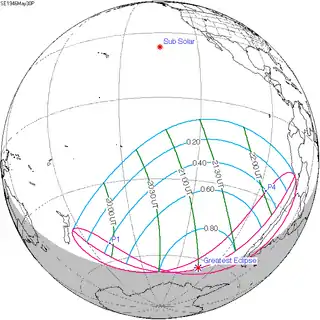 Partial |
122 | November 23, 1946 Partial | |
| 127 | May 20, 1947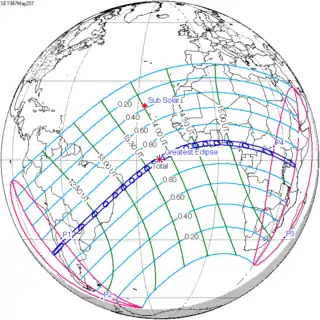 Total |
132 | November 12, 1947 Annular | |
| 137 | May 9, 1948 Annular |
142 | November 1, 1948 Total | |
| 147 | April 28, 1949 Partial |
152 | October 21, 1949 Partial | |
Saros 137
It is a part of Saros cycle 137, repeating every 18 years, 11 days, containing 70 events. The series started with partial solar eclipse on May 25, 1389. It contains total eclipses from August 20, 1533 through December 6, 1695, first set of hybrid eclipses from December 17, 1713 through February 11, 1804, first set of annular eclipses from February 21, 1822 through March 25, 1876, second set of hybrid eclipses from April 6, 1894 through April 28, 1930, and second set of annular eclipses from May 9, 1948 through April 13, 2507. The series ends at member 70 as a partial eclipse on June 28, 2633. The longest duration of totality was 2 minutes, 55 seconds on September 10, 1569. Solar Saros 137 has 55 umbral eclipses from August 20, 1533 through April 13, 2507 (973.62 years). That's almost 1 millennium!
| Series members 30–40 occur between 1901 and 2100: | ||
|---|---|---|
| 30 | 31 | 32 |
 April 17, 1912 |
 April 28, 1930 |
 May 9, 1948 |
| 33 | 34 | 35 |
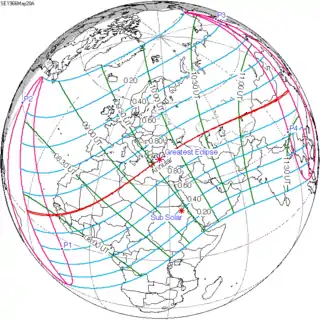 May 20, 1966 |
 May 30, 1984 |
 June 10, 2002 |
| 36 | 37 | 38 |
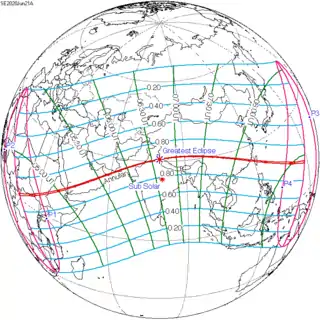 June 21, 2020 |
 July 2, 2038 |
 July 12, 2056 |
| 39 | 40 | |
 July 24, 2074 |
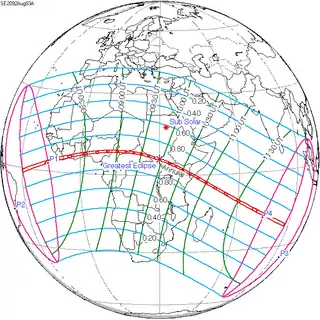 August 3, 2092 | |
Inex series
This eclipse is a part of the long period inex cycle, repeating at alternating nodes, every 358 synodic months (≈ 10,571.95 days, or 29 years minus 20 days). Their appearance and longitude are irregular due to a lack of synchronization with the anomalistic month (period of perigee). However, groupings of 3 inex cycles (≈ 87 years minus 2 months) comes close (≈ 1,151.02 anomalistic months), so eclipses are similar in these groupings.
| Inex series members between 1901 and 2100: | ||
|---|---|---|
 May 29, 1919 (Saros 136) |
 May 9, 1948 (Saros 137) |
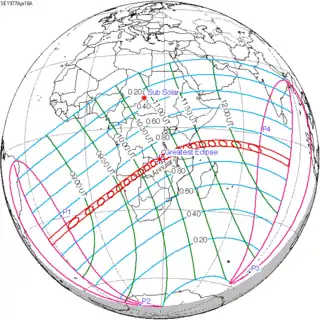 April 18, 1977 (Saros 138) |
 March 29, 2006 (Saros 139) |
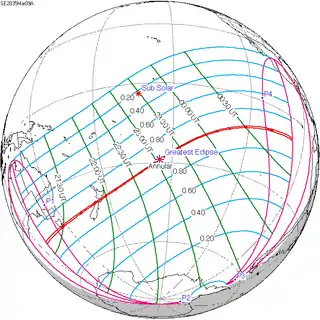 March 9, 2035 (Saros 140) |
 February 17, 2064 (Saros 141) |
 January 27, 2093 (Saros 142) |
||
Tritos series
This eclipse is a part of a tritos cycle, repeating at alternating nodes every 135 synodic months (≈ 3986.63 days, or 11 years minus 1 month). Their appearance and longitude are irregular due to a lack of synchronization with the anomalistic month (period of perigee), but groupings of 3 tritos cycles (≈ 33 years minus 3 months) come close (≈ 434.044 anomalistic months), so eclipses are similar in these groupings.
| Series members between 1901 and 2100 | |||
|---|---|---|---|
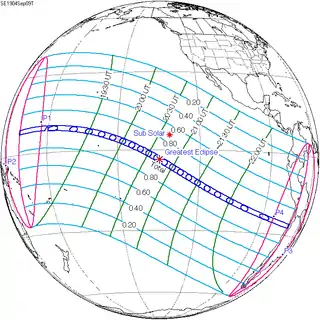 September 9, 1904 (Saros 133) |
 August 10, 1915 (Saros 134) |
 July 9, 1926 (Saros 135) | |
 June 8, 1937 (Saros 136) |
 May 9, 1948 (Saros 137) |
 April 8, 1959 (Saros 138) | |
 March 7, 1970 (Saros 139) |
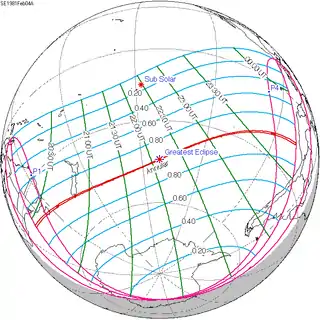 February 4, 1981 (Saros 140) |
 January 4, 1992 (Saros 141) | |
 December 4, 2002 (Saros 142) |
 November 3, 2013 (Saros 143) |
 October 2, 2024 (Saros 144) | |
 September 2, 2035 (Saros 145) |
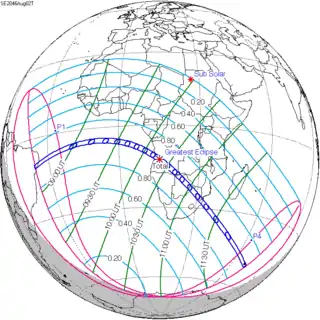 August 2, 2046 (Saros 146) |
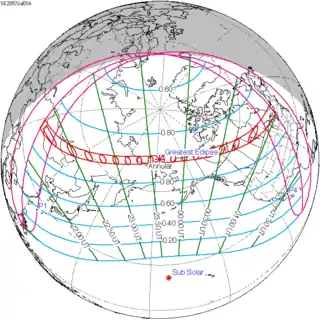 July 1, 2057 (Saros 147) | |
 May 31, 2068 (Saros 148) |
 May 1, 2079 (Saros 149) |
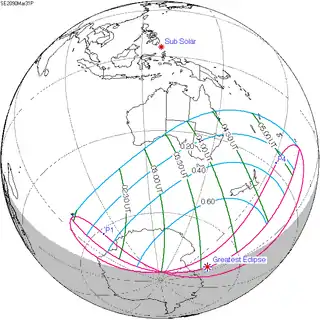 March 31, 2090 (Saros 150) | |
Metonic series
The metonic series repeats eclipses every 19 years (6939.69 days), lasting about 5 cycles. Eclipses occur in nearly the same calendar date. In addition, the octon subseries repeats 1/5 of that or every 3.8 years (1387.94 days).
| 21 eclipse events between July 21, 1906 and July 20, 1982 | ||||
|---|---|---|---|---|
| July 20–21 | May 9 | February 24–25 | December 13–14 | October 1–2 |
| 105 | 107 | 109 | 111 | 113 |
 December 13, 1898 |
||||
| 115 | 117 | 119 | 121 | 123 |
 July 21, 1906 |
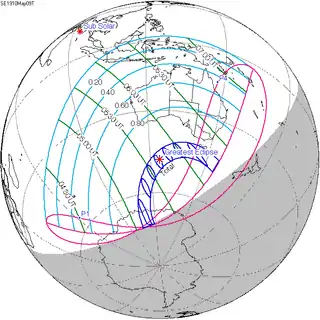 May 9, 1910 |
 February 25, 1914 |
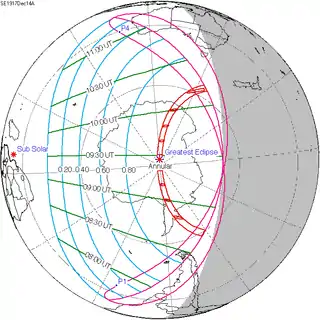 December 14, 1917 |
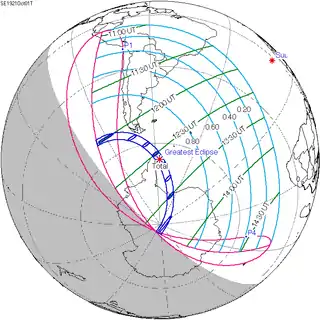 October 1, 1921 |
| 125 | 127 | 129 | 131 | 133 |
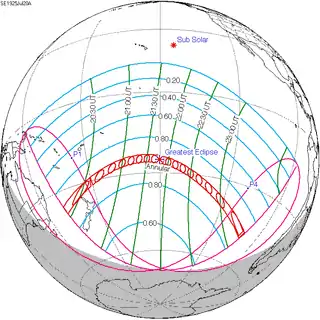 July 20, 1925 |
 May 9, 1929 |
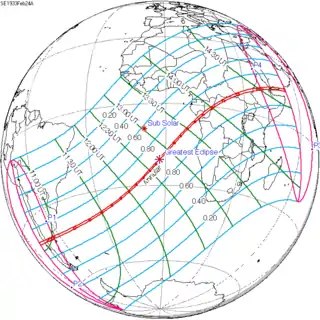 February 24, 1933 |
 December 13, 1936 |
 October 1, 1940 |
| 135 | 137 | 139 | 141 | 143 |
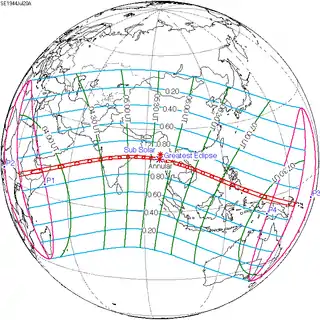 July 20, 1944 |
 May 9, 1948 |
 February 25, 1952 |
 December 14, 1955 |
 October 2, 1959 |
| 145 | 147 | 149 | 151 | 153 |
 July 20, 1963 |
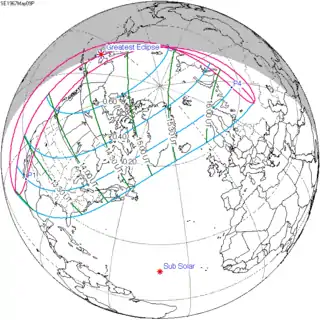 May 9, 1967 |
 February 25, 1971 |
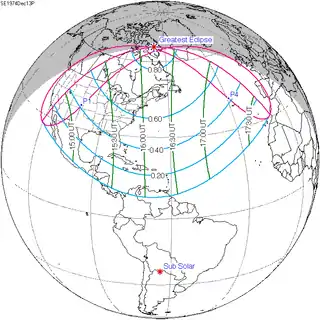 December 13, 1974 |
 October 2, 1978 |
| 155 | ||||
 July 20, 1982 | ||||
Notes
- van Gent, R.H. "Solar- and Lunar-Eclipse Predictions from Antiquity to the Present". A Catalogue of Eclipse Cycles. Utrecht University. Retrieved 6 October 2018.
References
- Earth visibility chart and eclipse statistics Eclipse Predictions by Fred Espenak, NASA/GSFC
.jpg.webp)

